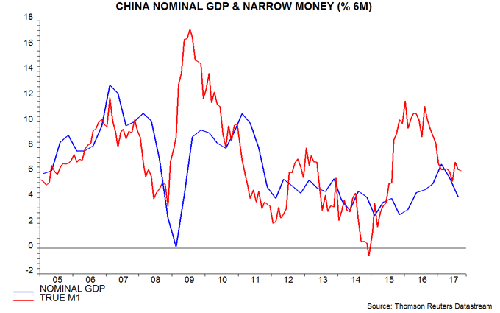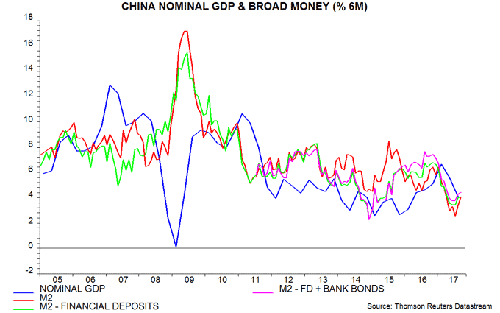
Janus Henderson: Chinese growth holding up
The Chinese economy has cooled since early 2017 but growth remains respectable and current monetary trends are reassuring.
20.10.2017 | 13:09 Uhr
Nominal GDP is a better guide to economic fluctuations in China than official real GDP growth numbers, which often show little variation. Two-quarter growth of nominal GDP, seasonally adjusted, peaked in the first quarter of 2017, falling significantly in the second and third quarters. A slowdown had been signalled by a sharp drop in six-month narrow money expansion between August 2016 and February 2017 – see first chart(*). (* True M1 = official M1 + household demand deposits.)

Narrow money growth, however, has stabilised since early 2017 at a solid level by historical standards. Current growth is much stronger than in late 2014 / early 2015, when the economy was in danger of entering a deflationary recession. Aggressive monetary and fiscal policy easing averted this risk and set the stage for the late 2016 / early 2017 boomlet.
Monetary pessimists highlight weakness in broad money M2 – six- and 12-month growth of this measure recently reached new lows in data extending back to the early 1990s. As previously discussed, however, M2 has been distorted by large swings in deposit holdings of non-bank financial institutions – movements in such deposits are unlikely to provide information about near-term prospects for spending on goods and services.
An additional suppressing factor since 2015 has been a switch by households and non-financial enterprises out of time deposits into money market funds and wealth management products, which have channelled the funds back to the banks via purchases of bank bonds. Such bonds are excluded from the M2 definition.
An adjusted broad money measure excluding financial deposits and adding bank bonds has been better correlated with nominal GDP than M2 in recent years – second chart. Six-month growth of this measure is below the historical average but has recovered since June and is higher than in late 2014 / early 2015.

Broad money, therefore, is giving a less upbeat message than narrow money but does not suggest economic weakness.
The expectation here, based on the above, is that nominal GDP growth will stabilise around its recent lower level through early 2018.
One risk to an optimistic view is that the tightening of monetary policy during the first half of the year has yet to be fully reflected in monetary trends. Near-term economic resilience, moreover, may sustain recent upward pressure on inflation, causing further restrictive policy moves.



Diesen Beitrag teilen: